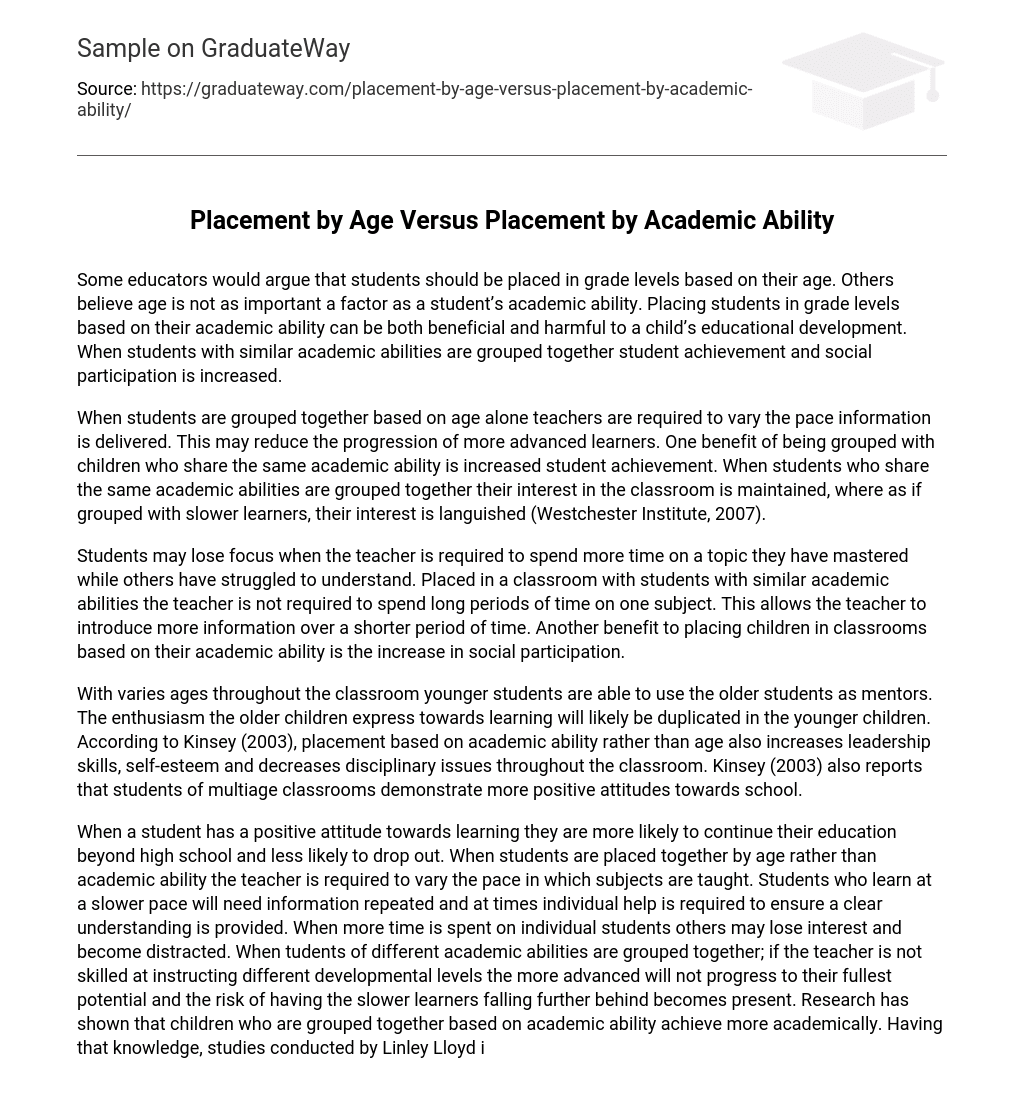Some educators would argue that students should be placed in grade levels based on their age. Others believe age is not as important a factor as a student’s academic ability. Placing students in grade levels based on their academic ability can be both beneficial and harmful to a child’s educational development. When students with similar academic abilities are grouped together student achievement and social participation is increased.
When students are grouped together based on age alone teachers are required to vary the pace information is delivered. This may reduce the progression of more advanced learners. One benefit of being grouped with children who share the same academic ability is increased student achievement. When students who share the same academic abilities are grouped together their interest in the classroom is maintained, where as if grouped with slower learners, their interest is languished (Westchester Institute, 2007).
Students may lose focus when the teacher is required to spend more time on a topic they have mastered while others have struggled to understand. Placed in a classroom with students with similar academic abilities the teacher is not required to spend long periods of time on one subject. This allows the teacher to introduce more information over a shorter period of time. Another benefit to placing children in classrooms based on their academic ability is the increase in social participation.
With varies ages throughout the classroom younger students are able to use the older students as mentors. The enthusiasm the older children express towards learning will likely be duplicated in the younger children. According to Kinsey (2003), placement based on academic ability rather than age also increases leadership skills, self-esteem and decreases disciplinary issues throughout the classroom. Kinsey (2003) also reports that students of multiage classrooms demonstrate more positive attitudes towards school.
When a student has a positive attitude towards learning they are more likely to continue their education beyond high school and less likely to drop out. When students are placed together by age rather than academic ability the teacher is required to vary the pace in which subjects are taught. Students who learn at a slower pace will need information repeated and at times individual help is required to ensure a clear understanding is provided. When more time is spent on individual students others may lose interest and become distracted. When tudents of different academic abilities are grouped together; if the teacher is not skilled at instructing different developmental levels the more advanced will not progress to their fullest potential and the risk of having the slower learners falling further behind becomes present. Research has shown that children who are grouped together based on academic ability achieve more academically. Having that knowledge, studies conducted by Linley Lloyd in 2000 show that most parents were happier when their children are among the youngest in the classroom (2001).
Many parents state “the increased opportunity for stimulation from older students” is the reason they prefer multiage groupings (Holloway, 2001). Today many schools have found a way to utilize both academic grouping and age grouping throughout the classroom. Grouping within the classroom is very common in many elementary schools in the United States. Grouping within the classroom consists of one class with students similar in age, divided into small groups based on academic ability. For example a class of 20 may have two groups of ten.
Group one may be more advanced in math, while group two consist of children who struggle with the subject. This allows the teacher to give instruction in varies ways. The teacher may explain the assignment to the entire class or individually to the groups. Because the more advanced students are more likely to work independently with little help the teacher is able to focus more attention to the slower progressing students. Once group one is started on the assignment the teacher can spend more time assisting the students in group two who struggle and require more attention and detailed explanations.
The argument of placing students in classrooms based on academic ability or age has been ongoing for several years. Studies have shown advantages and disadvantages in both grouping methods. Before making a decision you should consider the way in which the child learns. Does the child work better in small groups? Is the child timid and less likely to participate in a subject due to their lack of knowledge? While there is no right or wrong way to group children in a classroom, ultimately the decision is up to the parent and the teachers.





